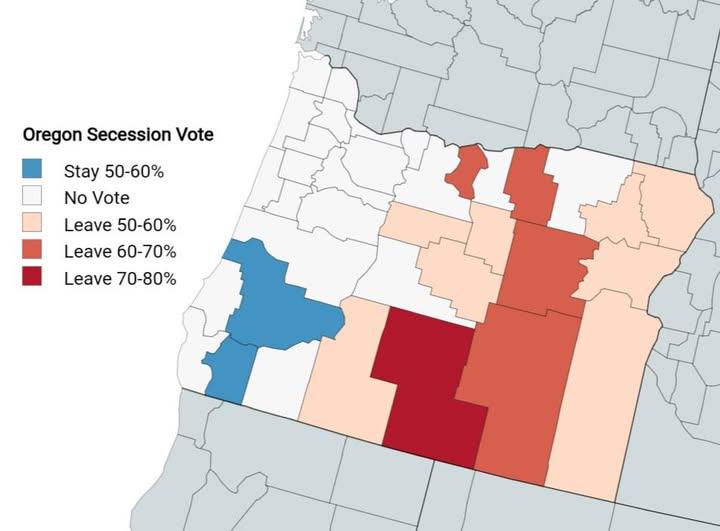Oregon Counties Voted to Join Idaho Map


Marcus Rodriguez
Historical Geography Expert
Marcus Rodriguez specializes in historical cartography and geographic data analysis. With a background in both history and geography, he brings unique...
Geographic Analysis
What This Map Shows
This map visually represents the counties in Oregon that have expressed a desire to leave the state and join Idaho between 2020 and 2024. It highlights the geographic regions where this sentiment is most pronounced, illustrating a growing movement among certain communities that feel disconnected from the policies and governance of Oregon. The visualization captures not just the counties involved but also the broader socio-political dynamics at play.
Deep Dive into the Movement
The desire for some Oregon counties to join Idaho is rooted in a complex interplay of cultural, economic, and political factors. The movement, often referred to as the "Greater Idaho" initiative, reflects a belief among residents in these counties that their values and needs align more closely with those of Idaho than with the urban-centric policies of Oregon’s state government. Interestingly, the counties involved are primarily rural areas, characterized by agricultural land, natural resources, and a more conservative political climate.
As of 2024, the counties showing significant support for this movement include places like Jefferson, Union, and Baker counties, among others. Collectively, these counties represent a small portion of Oregon's overall population but embody a significant ideological divergence. For instance, Baker County, with its rugged landscapes and rich history of mining and agriculture, has a population that often feels overlooked in state-level decisions that prioritize urban development over rural interests.
The push for joining Idaho is also tied to issues like taxation, resource management, and public policy. Many residents argue that Idaho's lower taxes and less restrictive regulations would benefit their local economies. Moreover, the cultural identities in these counties—often steeped in a frontier spirit and self-reliance—clash with what they perceive as the more progressive and urban-focused policies of Oregon.
Statistically, rural Oregon has been losing residents to nearby states like Idaho, where economic opportunities and lifestyle appeal to those seeking a different pace of life. In fact, data from the U.S. Census Bureau indicates that counties along the Oregon-Idaho border have seen a noticeable influx of new residents from Oregon, further fueling the desire for formal political change. This demographic shift raises questions about the long-term viability of rural communities in Oregon if the trend continues.
Regional Analysis
When analyzing the map, it’s essential to consider the geographical context of the counties involved. Regions like the Willamette Valley, which are heavily populated and urbanized, have starkly different interests compared to the rural counties pushing for secession. For example, while cities like Portland and Salem focus on progressive policies addressing climate change and social equity, the rural counties are more concerned about land use, agricultural viability, and economic independence.
In eastern Oregon, counties like Harney and Malheur have historically experienced economic challenges, making the prospect of joining Idaho appealing as residents hope to benefit from Idaho's policies and economic conditions. Conversely, the coastal counties, which are not part of the movement, prioritize environmental protections and tourism, resulting in a significant divide in policy priorities.
Significance and Impact
The implications of this movement extend beyond mere political boundaries. If counties were to successfully join Idaho, it would not only reshape the political landscape but also impact local economies, social services, and resource management. This situation raises fundamental questions about representation in governance and the extent to which local voices can influence larger state policies.
Moreover, the Greater Idaho movement mirrors trends seen in other parts of the United States, where rural areas feel increasingly marginalized by urban-centric governance. Understanding the motivations behind this movement can shed light on broader national conversations about state representation, resource allocation, and the future of rural America. As we look to the future, it will be fascinating to see how this movement evolves and whether it will spark similar initiatives elsewhere in the country. Will these counties find a more suitable political home in Idaho, or will they continue to advocate for their interests within Oregon? The answers to these questions could have lasting implications for both states and their residents.
Visualization Details
- Published
- October 17, 2025
- Views
- 42
Comments
Loading comments...